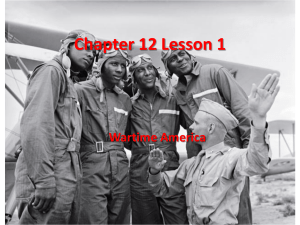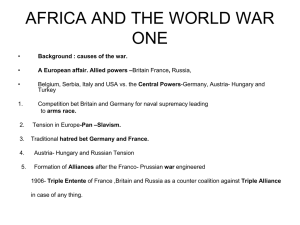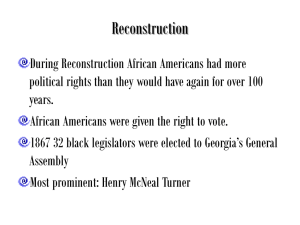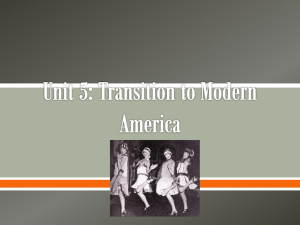Segregation in the US Military
advertisement
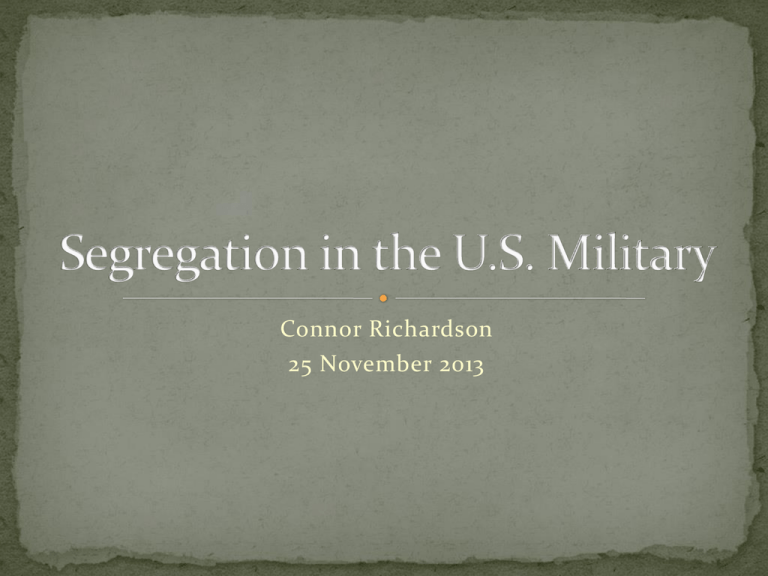
Connor Richardson 25 November 2013 History of segregation in wars Revolutionary War The War of 1812 The Civil War World War I World War II Red Tails Executive Order 9981 Korean War African Americans have fought in every war Poorly trained and equipped Returned home to worse conditions "Once let the black man get upon his person the brass letter, U.S., let him get an eagle on his button, and a musket on his shoulder and bullets in his pocket, there is no power on earth that can deny that he has earned the right to citizenship.“ - Frederick Douglass 13 Colonies vs. the British Government African-Americans served on both sides 5000 black soldiers served with whites in the Continental Army Due to a shortage of men, General Washington lifted the ban on black enlistment in the Continental Army U.S. Declared war on Great Britain: Economic blockade of France Induction of neutral American seamen into the British Royal Navy against their will Supported Indian tribes along the Great Lakes frontier Many African Americans fought in the U.S. military 26th infantry division Sailors in the navy Fought between the North and South U.S. States' rights versus federal authority Westward expansion Slavery Blacks assigned to non-combat roles and led by white 180,000 African Americans comprising 163 units served in the Union Army Only two recorded units from the Confederate Army First black received the Medal of Honor Sgt. Major Christian Fleetwood Still Completely segregated – yet many African Americans volunteered More than 350,000 served – Most were non-combat The Great Migration 500,000 African Americans moved North Social, economic, and political challenges Fought with integrated British soldiers Contradiction of fighting against Nazi Germany with a segregated military Experimented with integrated troops near the end of the war as a result of the Battle of the Bulge U.S. fought for freedoms African Americans faced segregation, violence, and could not vote A. Philip Randolph fought for the African Americans to become pilots Tuskegee Institute – Flight school for African Americans Tuskegee Experience – Army Air Corps program to become pilots and mechanics First African American military aviators Only fighter escort to never lose a bomber to enemy action President Truman established the Committee on Civil Rights in 1946 Documented violations and racial violence African American soldiers served in a racist environment Urged Truman to end racism African Americans would refuse to serve 26 July 1948 – President Truman signed the order Rid the military of discrimination against race, color, religion, or national origin “It is hereby declared to be the policy of the President that there shall be equality of treatment and opportunity for all persons in the armed services without regard to race, color, religion or national origin. This policy shall be put into effect as rapidly as possible, having due regard to the time required to effectuate any necessary changes without impairing efficiency or morale." Served in all combat units 100,000 on active duty at beginning Over 600,000 served by the end Last all-black unit was disbanded Blacks served in command positions Around 5,000 died in combat Many chose to stay in the military after the war Jesse L. Brown 1775-1783 Revolutionary War 1861-1865 The Civil War 1939-1945 World War II 1950-1953 Korean War Civil Rights Movement 1812-1814 War of 1812 1914-1918 World War I 1948 Executive Order 9981 History of segregation in wars Revolutionary War The War of 1812 The Civil War World War I World War II Red Tails Executive Order 9981 Korean War "A Brief History." Tuskegee Airmen Inc RSS. N.p., n.d. Web. 17 Nov. 2013. <http://tuskegeeairmen.org/explore-tai/a-brief-history/>. "African Americans in the Korean War." NEW JERSEY KOREAN WAR VETERANS MEMORIAL. N.p., n.d. Web. 17 Nov. 2013. <http://www.nj.gov/military/korea/factsheets/afroamer.html>. "African-American Soldiers in the Civil War." History.com. A&E Television Networks, n.d. Web. 17 Nov. 2013. <http://www.history.com/topics/african-american-soldiers-in-the-civil-war>. "American Revolution." History.com. A&E Television Networks, n.d. Web. 17 Nov. 2013. <http://www.history.com/topics/american-revolution>. McGrath, Jane. "Why Was Executive Order No. 9981 so Important?" HowStuffWorks. N.p., n.d. Web. 17 Nov. 2013. <http://history.howstuffworks.com/history-vs-myth/executive-order-99812.htm>. Vox, Lisa. "Executive Order 9981." About.com African-American History. N.p., n.d. Web. 17 Nov. 2013. <http://afroamhistory.about.com/od/civilrightsstruggle1/a/order9981.htm>. Weidman, Budge. "Teaching With Documents:The Fight for Equal Rights: Black Soldiers in the Civil War." Black Soldiers in the Civil War. N.p., n.d. Web. 17 Nov. 2013. <http://www.archives.gov/education/lessons/blacks-civil-war/>. Williams, Chad. "African Americans and World War I." African Americans and World War I. N.p., n.d. Web. 17 Nov. 2013. <http://exhibitions.nypl.org/africanaage/essay-world-war-i.html>. "World War I." History.com. A&E Television Networks, n.d. Web. 17 Nov. 2013. <http://www.history.com/topics/world-war-i>.
